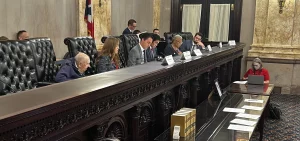News
Ohio’s Ballot Board adopts controversial language for the proposed abortion amendment
By: Jo Ingles | Statehouse News Bureau
Posted on:
COLUMBUS, Ohio (Statehouse News Bureau) — The Ohio Ballot Board has adopted summary language that voters would see on their ballots when they go to the polls in November to vote on a proposed constitutional amendment to enshrine abortion rights into the state constitution. Backers of the amendment say the language adopted is inaccurate and biased — and they are considering a lawsuit.

Lauren Blauvelt with Ohioans United for Reproductive Rights said the language adopted is incorrect and political.
“The entire summary is propaganda that is written by anti-abortion politicians,” Blauvelt said.
Democrats had wanted the board to use the 250-word amendment as the ballot summary. But Republican Secretary of State Frank LaRose, who is against abortion rights, said that was too long. Democratic State Rep. Elliot Forhan (D-South Euclid) wasn’t buying LaRose’s explanation.
“Two-hundred and fifty words — that’s a letter to the editor to the Plain Dealer,” Forhan said.
But Mike Gonidakis, president of Ohio Right to Life, defended the summary language that was adopted. And he said use of the term “unborn child” makes sense.
“In the Ohio Revised Code, there’s a definition of an unborn child so they are not making up language,” Gonidakis said.
Ballot board member Theresa Gavarone (R-Bowling Green) made several controversial statements when defending the language that was ultimately adopted. She said the language of the amendment was too broad.
“No one should be fooled by the clever language of this amendment. It’s designed to be broad. So broad that should it pass it is unequivocally true that access to painful late term abortions will be written into Ohio’s constitution,” Gavarone said, adding, “it’s a bridge too far.”
Democratic Rep. Paula Hicks-Hudson said she was appalled by Gavarone’s language.
Backers of the amendment said they are considering a lawsuit over the proposed language. If they file, it would go before the Republican-dominated Ohio Supreme Court on which three of the four GOP justices have publicly declared personal anti-abortion stances.
The board also unanimously approved new ballot summary language for an initiated statute that, if passed, would create a law to allow Ohioans 21 years and older to purchase and use marijuana. That measure will be known as State Issue 2.

